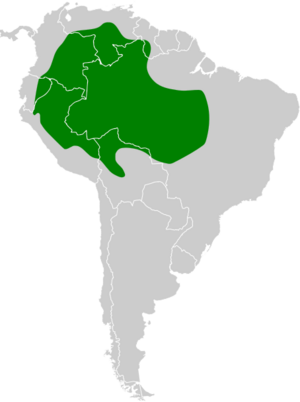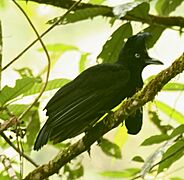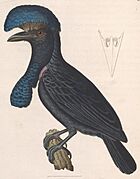Amazonian umbrellabird facts for kids
Quick facts for kids Amazonian umbrellabird |
|
|---|---|
 |
|
| Female | |
| Conservation status | |
| Scientific classification | |
| Genus: |
Cephalopterus
|
| Species: |
ornatus
|
 |
|
The Amazonian umbrellabird (Cephalopterus ornatus) is a really interesting bird that lives in the Amazon basin. You can also find a separate group of them on the eastern slopes of the Andes mountains.
Imagine a bird that's almost completely black! The male umbrellabird has a cool black crest on its head. It also has a special inflatable pouch, called a wattle, on its throat. This bird is quite large, growing to about 48 to 55 centimeters (19 to 22 inches) long. It might even be the biggest passerine bird in all of South America! (A passerine is a type of bird that can perch, like a robin, but much larger in this case). The female is a little smaller than the male.
Both male and female umbrellabirds have a unique way of flying. Their flight is wavy, almost like a woodpecker. The male is known for its super loud, booming call that echoes through the forest.
These birds mostly eat fruit and berries. Sometimes, they also snack on insects and spiders if they get the chance. They usually look for food alone, in pairs, or in small groups. You'll find them high up in the forest canopy, which is the top layer of trees. They hop from branch to branch, but they are quite shy. Because they are so secretive, you're more likely to hear their loud call than to actually see them!
Meet the Amazonian Umbrellabird
The male Amazonian umbrellabird is much bigger than the female. It's probably the largest passerine bird in South America. It might also be the largest suboscine passerine bird in the world!
A male Amazonian umbrellabird can weigh between 480 to 571 grams (1.06 to 1.26 pounds). It can also be 48 to 55 centimeters (19 to 22 inches) long. The female is usually smaller, standing about 41 to 44 centimeters (16 to 17 inches) tall. She weighs up to 380 grams (0.84 pounds).
Like other umbrellabirds, this species is almost entirely black. They have a noticeable crest on top of their head. They also have an inflatable wattle on their neck. This wattle helps to make their loud, booming calls even louder!
This specific umbrellabird has pale eyes. Other types of umbrellabirds usually have black eyes. When they fly, they move in a wavy way, much like a woodpecker. You can tell them apart from large woodpeckers because umbrellabirds don't have any white feathers.
You usually see the Amazonian umbrellabird flying only across open spaces in the forest, like over rivers. When they are in trees, they boldly hop from branch to branch.
Where Do They Live?
The Amazonian umbrellabird lives in most of the huge Amazon basin. This area stretches from the foothills of the Andes mountains in Colombia, Ecuador, Peru, and Bolivia. It goes east to the south of Venezuela, near the Orinoco River. You can also find them in parts of southwestern Guyana and Brazil. In Brazil, they live eastward to the Negro and Xingú river basins. They also go southward to southern Mato Grosso, reaching the start of the Paraguay River.
There are two main groups of these birds. One group lives in woodlands and forests, mostly near rivers, in the Amazon basin. The second group lives in the forested foothills of the eastern Andes.
You might see Amazonian umbrellabirds in small groups, in pairs, or sometimes by themselves. They are usually found in or near the forest canopy. However, they are very careful and don't often show themselves in open spots. This makes them hard to spot, even though they are quite large birds. You will hear their calls more often than you will see them in the wild.
Their favorite foods are fruit and berries. But they are also happy to eat insects, spiders, and insect larvae when they find them.
Gallery





